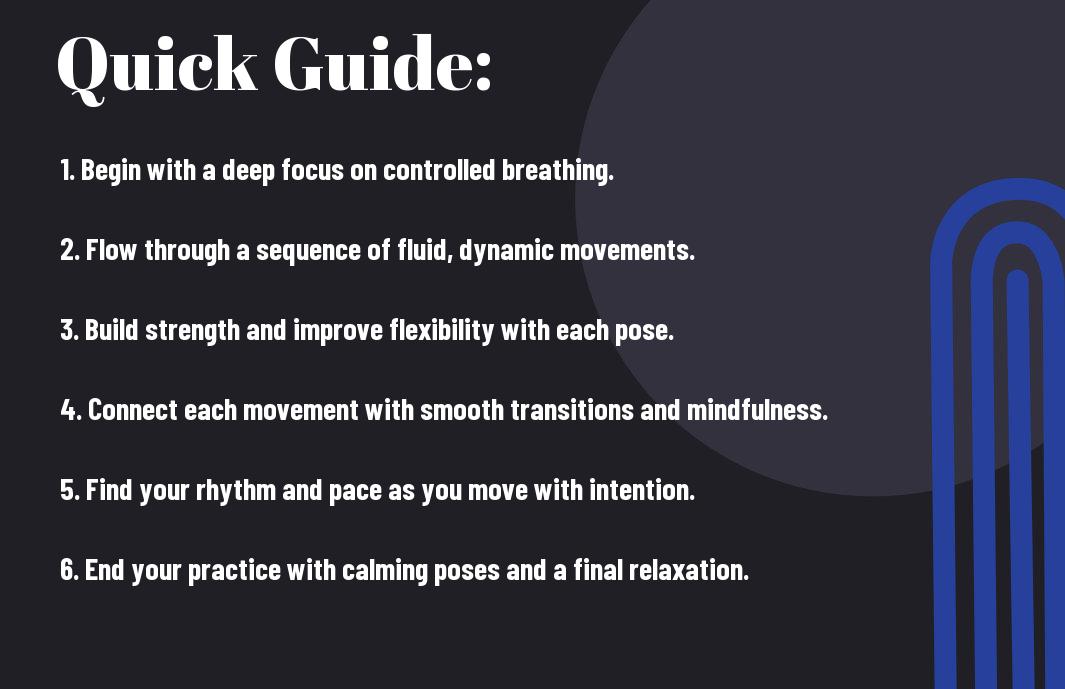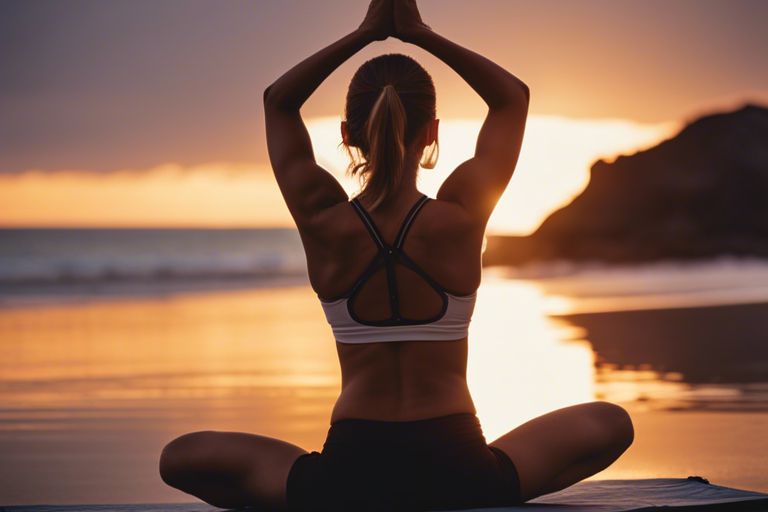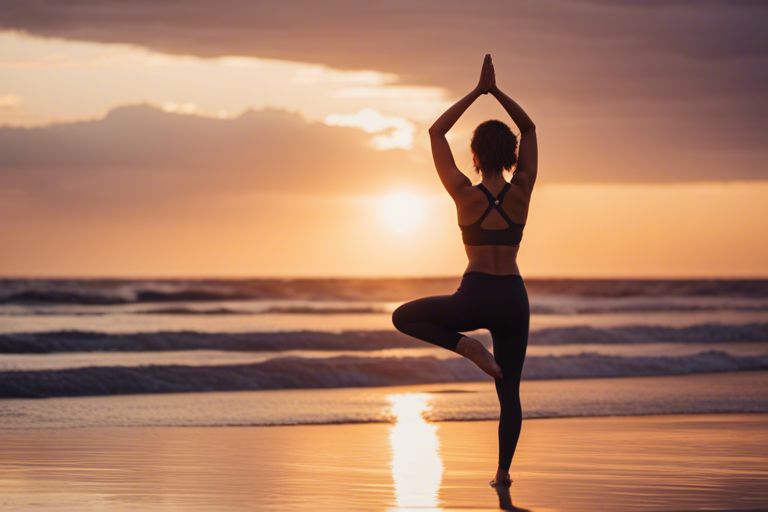Strength in yoga lies not just in holding poses, but in the fluidity of movement found in Vinyasa practice. This dynamic form of yoga synchronizes breath with continuous flowing postures, enhancing both strength and flexibility. Through controlled movements, Vinyasa builds strength while improving balance and endurance. Dive into the transformative practice of Vinyasa yoga to experience the powerful combination of physical movement and mental focus.
Key Takeaways:
- Vinyasa Yoga Focus: Vinyasa yoga emphasizes flowing movements coordinated with the breath, creating a dynamic practice that promotes strength and flexibility.
- Building Strength: Through consistent practice of vinyasa yoga, individuals can build strength in both their muscles and joints, improving overall physical fitness.
- Enhancing Flexibility: The consistent movement and stretching in vinyasa yoga can help individuals develop and enhance their flexibility, leading to better range of motion and reduced risk of injury.

Understanding Vinyasa Yoga
Definition and History
Your journey into the world of Vinyasa yoga begins with understanding its essence and roots. Vinyasa yoga is a dynamic practice that links movement with breath, creating a flow of poses that smoothly transition from one to another. This style of yoga is often referred to as “flow” yoga, emphasizing the coordination of breath and movement to build strength, flexibility, and mindfulness.
Vinyasa yoga has its origins in ancient Indian traditions and is a modern interpretation of Ashtanga yoga. Unlike Ashtanga, Vinyasa does not follow a set series of poses, allowing for more freedom and creativity in sequencing. This fluid style of yoga appeals to those who enjoy a more energetic and physically challenging practice.
Key Principles and Philosophy
For a deeper understanding of Vinyasa yoga, it’s important to explore its key principles and philosophy. Vinyasa yoga is based on the concept of connecting movement with breath, creating a meditative flow that encourages presence and awareness. This synchronization helps practitioners cultivate a sense of mindfulness throughout their practice, leading to a deeper connection between body, mind, and breath.
For instance, the emphasis on breath control (pranayama) in Vinyasa yoga not only helps regulate the body’s energy flow but also serves as a tool for maintaining focus and attention. By coordinating each movement with a specific breath, practitioners can enhance the mind-body connection and experience a sense of moving meditation on the mat.
Types of Vinyasa Yoga
While exploring the world of Vinyasa yoga, you will come across various types of this dynamic and flowing practice. Each type offers a unique approach to sequencing, breathwork, and movement, catering to different preferences and goals. Below are some popular types of Vinyasa yoga:
| Hatha Vinyasa | Ashtanga Vinyasa |
| Power Vinyasa | Restorative Vinyasa |
Hatha Vinyasa
On the spectrum of Vinyasa yoga practices, Hatha Vinyasa blends the traditional elements of Hatha yoga with the dynamic flow of Vinyasa. This style focuses on alignment, breath control, and mindfulness during the practice. Expect a balance of strength-building poses and rejuvenating stretches in a Hatha Vinyasa class.
Ashtanga Vinyasa
Assuming you step into an Ashtanga Vinyasa class, prepare yourself for a demanding and structured practice. This type of Vinyasa yoga follows a specific series of poses, each flowing into the next with synchronized breathing. Ashtanga Vinyasa is known for its challenging nature and emphasis on physical alignment and endurance.
It is recommended that practitioners have some yoga experience before delving into Ashtanga Vinyasa, as the pace and intensity of the practice can be quite demanding.
Power Vinyasa
Now, moving on to Power Vinyasa, this type of Vinyasa yoga amps up the intensity and pace of the practice. Expect a fast-paced flow with strong emphasis on building strength and endurance. Power Vinyasa classes often incorporate challenging poses and sequences, offering a dynamic and energizing experience.
For instance, Power Vinyasa can be a great option for those looking to push their physical limits and build muscle tone while enhancing flexibility and cardiovascular health.
Restorative Vinyasa
Some Vinyasa yoga practitioners may find solace in Restorative Vinyasa. This gentle and soothing practice focuses on deep relaxation and stress relief through supported poses and mindful breathing. Restorative Vinyasa classes aim to release tension and restore balance to the body and mind.
Yoga practitioners looking to nurture their bodies and promote overall well-being may find Restorative Vinyasa to be a beneficial complement to their practice.
Tips for Practicing Vinyasa Yoga
Many tips can help you make the most out of your Vinyasa yoga practice. Here are some crucial guidelines to enhance your experience:
- Focus on your breath: Vinyasa yoga is all about linking breath with movement. Make sure to synchronize your breathing with each pose to flow smoothly through the sequence.
- Listen to your body: Pay attention to how your body feels during the practice. If something doesn’t feel right, adjust or skip a pose to prevent injury.
- Stay present: Mindfulness is key in Vinyasa yoga. Try to stay in the moment and let go of distractions to fully immerse yourself in the practice.
Assume that practicing Vinyasa yoga with these tips in mind will elevate your practice and help you reap its benefits.
Breathing Techniques
Tips for incorporating proper breathing techniques in Vinyasa yoga include taking deep breaths in sync with your movements. For more information on how Hatha vs. Vinyasa Yoga: Benefits and How They Differ, visit the link.
Alignment and Posture
Some important tips for maintaining proper alignment and posture during Vinyasa yoga include engaging your core muscles, keeping your spine neutral, and aligning your joints correctly to prevent strain on your body.
Another important aspect of alignment and posture is to make sure that you distribute your weight evenly and avoid locking your joints to avoid injuries. A good way to check your alignment is by practicing in front of a mirror or seeking guidance from an experienced instructor.
Modifying for Beginners
With modifications for beginners, you can ease into Vinyasa yoga practice by starting with simpler poses, using props for support, and gradually increasing the intensity as you build strength and flexibility. It’s crucial to honor your body’s limits and not push yourself beyond what feels comfortable.
Beginners should focus on mastering the basic poses and transitions before advancing to more challenging sequences. By taking it slow and listening to your body, you can progress safely in your Vinyasa yoga journey.
Preventing Injuries
Now, it’s crucial to prioritize injury prevention when practicing Vinyasa yoga. It’s crucial to warm up properly before plunging into a practice, avoid overstretching, and respect your body’s limitations. It is also important to seek guidance from a qualified instructor to ensure you are performing poses correctly and safely.

Step-by-Step Guide to a Vinyasa Yoga Practice
Despite the dynamic and flowing nature of Vinyasa yoga, a structured practice can provide a framework for beginners and experienced practitioners alike. For a detailed 30-minute Vinyasa flow sequence, check out this 30-Minute Power Vinyasa Flow: Energize Your Practice.
| Warm-Up and Sun Salutations | Standing Postures and Balancing |
Warm-Up and Sun SalutationsEven before starting with dynamic movements, it’s important to warm up the body with gentle stretches targeting major muscle groups. Sun Salutations are a staple in Vinyasa yoga, linking breath with movement to set the pace for the practice. |
Standing Postures and BalancingClearly, standing postures like Warrior poses and balancing poses such as Tree pose help build strength, stability, and focus. These poses require engagement of the core and lower body while improving balance and concentration. |
The transition from one pose to another in Vinyasa yoga sequences is smooth and continuous, requiring both strength and flexibility. The Standing Postures and Balancing segment challenges practitioners to find stability and poise in each posture.
Seated Postures and Forward Folds
Folds Seated postures like Forward Folds and Seated Twists allow for a deeper stretch and release in the lower back, hamstrings, and hips. These poses also help calm the mind and promote introspection, making them a vital part of a Vinyasa practice.
A proper alignment and mindful movement are key in Seated Postures and Forward Folds to prevent strain or injury and enhance the benefits of each pose.
Backbends and Twists
A Vinyasa practice typically includes backbends to open the chest and heart center, as well as twists to improve spinal mobility and detoxify the body. These poses offer a balance of energizing and grounding effects, stimulating the central nervous system.
Yoga Backbends and Twists encourage practitioners to find extension through the spine while maintaining a steady breath to create space and openness in the body.
Final Relaxation and Savasana
With Any Vinyasa practice, a period of final relaxation and Savasana is imperative to integrate the benefits of the practice and allow the body to rest and rejuvenate. This pose offers a chance to release tension and find a sense of calm and stillness.
WarmUp A proper warm-up, including joint rotations and gentle stretches, prepares the body for the dynamic movements and strength-building postures in a Vinyasa flow sequence. Strong attention to alignment and breath throughout the practice ensures a safe and effective experience for practitioners of all levels.
Factors to Consider for a Successful Vinyasa Yoga Practice
After deciding to commence on a Vinyasa yoga journey, there are several crucial factors to consider to ensure a successful practice. From finding a qualified instructor to setting realistic goals and expectations, each element plays a significant role in your yoga experience.
Finding a Qualified Instructor
Little can compare to the guidance and knowledge of a qualified yoga instructor when starting your Vinyasa practice. Look for teachers who are certified and have experience in leading Vinyasa classes. A good instructor can help you refine your alignment, prevent injuries, and progress in your practice safely.
Creating a Home Practice Space
To create a home practice space for Vinyasa yoga, designate an area in your home that is quiet, spacious, and free from distractions. Invest in a good quality yoga mat that provides enough cushioning and grip for your practice. Additionally, consider adding props such as blocks, straps, and blankets to support your poses and enhance your practice.
Home practice in Vinyasa yoga allows you to cultivate a consistent routine and deepen your connection to the practice. Ensure your space is well-ventilated and has natural light to create a peaceful and energizing environment.
Investing in Proper Equipment
Little can impact your Vinyasa practice more than having the proper equipment to support and enhance your practice. Consider investing in high-quality yoga gear such as mats, blocks, straps, and bolsters. These props can assist you in maintaining alignment, deepening stretches, and advancing your practice.
Setting Realistic Goals and Expectations
If you want to progress in your Vinyasa practice, it is important to set realistic goals and have reasonable expectations. Understand that progress takes time and consistency, and avoid comparing yourself to others in the class. Focus on your personal growth and celebrate small achievements along the way.
Pros and Cons of Vinyasa Yoga
| Pros | Cons |
|---|---|
| Improves strength and flexibility | Risk of injury due to fast-paced movements |
| Enhances focus and mental clarity | Intensity may be too high for beginners |
| Increases cardiovascular fitness | Not suitable for those with certain physical limitations |
| Promotes mindfulness and stress relief | Requires a certain level of fitness to keep up |
Physical Benefits: Strength, Flexibility, and Balance
Little by little, vinyasa yoga helps in building strength, increasing flexibility, and improving balance. The continuous flow of movements challenges various muscle groups, leading to toning and strengthening over time.
Mental and Emotional Benefits: Stress Relief and Focus
Physical exertion during vinyasa yoga sessions can help release endorphins, the feel-good hormones, which can alleviate stress and improve mood. The focus on linking breath with movement also aids in sharpening concentration and enhancing mindfulness.
Vinyasa yoga is particularly beneficial for individuals looking to reduce stress levels and improve mental clarity. By syncing breath with movement, practitioners can cultivate a sense of presence and focus that carries over into daily life.
Potential Drawbacks: Injury Risk and Intensity
Prospective students should be aware of the potential risk of injury associated with vinyasa yoga, especially for beginners. The rapid pace of transitions between poses combined with the emphasis on proper alignment can increase the likelihood of strains or sprains if not practiced mindfully.
The intensity of vinyasa yoga classes might be overwhelming for some individuals, especially those who are new to the practice or have certain physical limitations. It’s important to listen to your body and modify poses as needed to prevent injury.
To wrap up
Following this exploration into the power of Vinyasa yoga, it is evident that this dynamic practice can significantly improve both strength and flexibility. By linking breath with movement, practitioners can cultivate a strong mind-body connection that enhances physical performance and mental focus. Vinyasa yoga offers a fluid and energetic style of practice that challenges practitioners to move with intention and mindfulness, promoting overall well-being and vitality.
Through a sequence of continuous flows and poses, Vinyasa yoga encourages students to explore their limits and expand their capabilities, both physically and mentally. This dynamic practice empowers individuals to build strength, improve flexibility, and cultivate a sense of inner peace and balance. By incorporating Vinyasa yoga into a regular fitness routine, one can experience the transformative power of movement, breath, and mindfulness in harmonizing the body, mind, and spirit.
FAQ
Q: What is Vinyasa Yoga?
A: Vinyasa Yoga is a dynamic style of yoga where you synchronize your breath with a continuous flow of postures. It involves moving from one pose to the next, smoothly and gracefully, creating a harmonious dance-like sequence.
Q: What are the benefits of practicing Vinyasa Yoga?
A: Practicing Vinyasa Yoga can help improve strength, flexibility, and balance. It also helps in reducing stress, increasing mindfulness, and promoting overall well-being. The dynamic movements in Vinyasa Yoga also help in improving cardiovascular health and circulation.
Q: Is Vinyasa Yoga suitable for beginners?
A: While Vinyasa Yoga can be challenging due to the continuous flow of movements, it is suitable for beginners with modifications and variations available for different levels of practitioners. It is important to listen to your body, practice at your own pace, and work with a qualified instructor who can guide you through the practice safely.











